#Vasilik
Text
Britney Spears'tan müjdeli haber! Efsane yeni şarkısıyla geri dönüyor
Britney Spears’tan müjdeli haber! Efsane yeni müziğiyle geri dönüyor
Dünyaca ünlü yıldız Britney Spears’ın ferdî hayatını ve parasını denetim eden babası Jamie Spears’ın 13 yıllık vasiliği geçtiğimiz aylarda sona erdi. Özgürlüğüne kavuşan ünlü pop yıldızı toplumsal internet hesabından yaptığı paylaşımla yeni müziğinin muştusunu verdi.
Dünyaca ünlü yıldız Britney Spears’ın ferdî hayatını ve…

View On WordPress
0 notes
Text
What the fuck is up with YouTube all the ads are in Spanish no hablo español why is there Professor from la casa de papel showing me a broken glass of water what are you talking about dude
#im not even watching anything related to Spanish#im watching Eponimo's Christmas podcasts and murder corner by Vasilikou#sugarenia talks
10 notes
·
View notes
Text


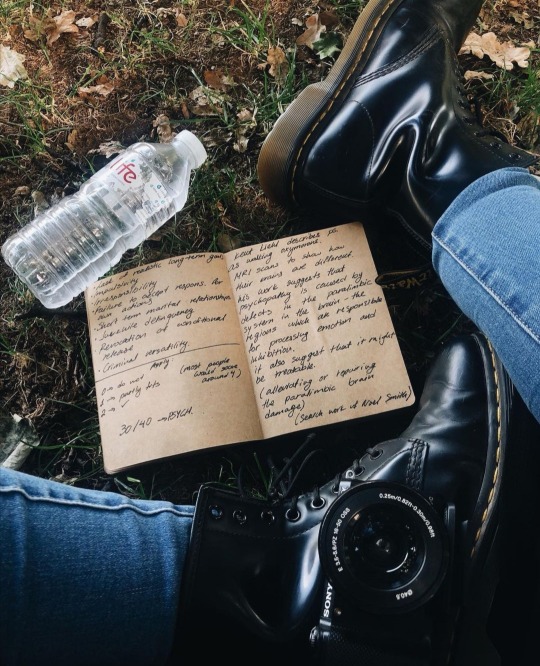





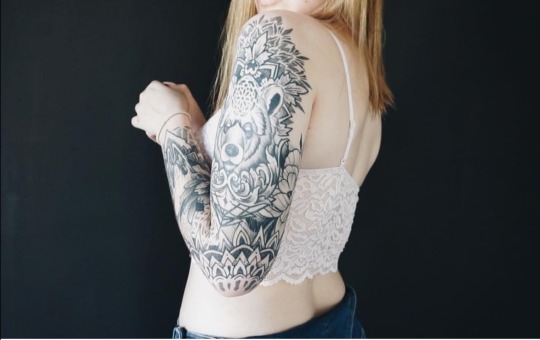

my comfort people
#Vasilikou#Maria vasilikou#emma chamberlain#chamberlain coffee#Comfort#aeshetic#coffee aesthetic#book aesthetic#Bookblr#greek tumblr#greektumblr#γκρικ ποστ#greek#greek aesthetic#γκρικ#greece#γρεεκ#love#ελληνικό tumblr#YouTube#Ελληνικοταμπλρ#Ελληνικό tumblr#Ελληνικα#Ελληνικότουιτερ#Ελλάδα#journaling#Cats#greek posts#greek quotes
6 notes
·
View notes
Text
ancient greek names
Abnoble Adelion Adria Aegesto Aerakon Aeraligus Affectiona Afrumful Agammemna Agath Aggres Agness Aileia Aileitos Aileme Ajanus Alame Alandra Alector Alemontron Aleris Aless Aleto Alexant Alexanthus Alexantius Alsius Anaxago Andinis Andready Androse Angered Angis Ankourgos Antevort Anthias Antia Apizzi Aponorba Aponus Appinna Aqual Ardea Ardia Armer Arnemena Arvera Ascender Augus Aurolia Avensta Balanes Balaudia Banna Baris Basilistos Belaina Berer Bevagnia Bluentia Bovius Brigenike Brigenna Bubonia Buxene Buxeno Calianos Callis Camer Camna Camucifer Camucium Canax Capis Carduinnes Caromarken Caustia Ceanona Celanus Cerea Cered Chaemium Charmenrva Charona Charos Chastaira Chiercula Chlory Cimaios Cletia Cloacitas Cloacitus Clotall Colonia Comiki Commonia Concas Conda Convecta Copiacchus Cordian Coveras Cunni Curydike Cymon Cymontum Daeda Damarkissa Damous Delagios Despoinos Diantus Discorus Domiki Dubrigant Durolican Durovia Earta Ebona Echoir Elagios Elenike Eless Elessorsa Elpid Elpomena Emped Entucadria Eraetonnus Erius Euadelaina Euadeon Euadeona Euphros Eutha Eutropiae Fabulina Fabus Famon Famonia Famountair Fearth Febrina Felica Fidens Fires Flamer Flamium Flampeia Flatina Flator Florina Floris Floritian Follo Fontia Fontronium Fotikosmos Fotionas Freedorus Froseidoul Furit Gales Galla Garicus Garriantum Garrior Gazellae Genia Glyceri Glycernus Glycerros Glykeris Glykou Godden Goldens Goritas Graclium Graton Gregillae Guardacaa Haidra Harias Haritasgus Heartas Heclata Hekated Helenia Helpertios Helpidamon Hephonos Herakon Heralas Heramna Herapon Herastaira Herminus Hesis Hilemonia Hispes Hittium Homerius Horos Horsa Hunta Hygin Hyginoton Hypatilla Hypation Hypatis Imatha Indinia Indorumful Indros Intha Intherator Iovardian Isiphone Joanna Jovide Joyfulvii Jupienua Jutum Juturnus Kadmost Kadmus Karion Kephaiden Kephemis Kephocas Kleithras Krona Lacho Lavertum Ledge Lefthe Lenina Leoplean Liberaea Libered Libereus Licus Ligeniacaa Lonas Lonnes Luxovia Lykerian Lysses Mached Maejan Maidentium Majoritas Mapon Marcaes Marcial Marknessa Maruse Medipus Meficinxia Melica Melicitas Melione Melix Melpis Menea Metha Metia Metra Milian Minus Mitia Moung Mutis Myros Myrroras Mytie Navenna Neces Nemaustus Neptimaios Nerodos Nikephos Nomina Noria Oceal Olian Olytie Orcia Ordian Oriae Oulis Ouranio Padros Paleria Pallios Pallisaac Pandrea Paraclius Parthy Peares Peduma Peopheus Persong Pertal Pertios Petroning Phain Phylus Piacernus Pienus Polle Pollo Pollum Polybright Potection Princinis Prior Psychesis Ptolene Pyros Quilomer Quiriplina Remestus Ressis Rheaveta Rhodion Rhodis Ricus Robius Roborvo Robus Roman Roxandro Rudge Rulancas Ruless Rumful Rutupit Saepiness Saepius Salia Saliasona Sarian Scial Sciplina Secuba Securia Secury Segon Semonius Sendove Sentus Servanuel Severis Severnund Severnus Shinis Shinium Shouta Shris Silippos Smemberate Solumnovis Sotikos Sotine Sountua Spyria Spyrrorsa Stain Stameria Stimintain Stitus Stranis Strater Strenea Suadne Subrae Sucetum Sulis Summanos Tacina Tacious Tamer Taormion Tedoul Temnone Terius Terna Ternus Terros Thalkyone Thecurias Themiltia Theni Thenoa Theodos Thermenea Tidius Timiant Titum Touta Tranos Trene Trenus Trina Trinum Trinus Tryphales Tryphasta Turnus Valexanthe Vasilike Veless Ventia Ventina Versian Vetellong Vetra Vheter Vheterium Victor Vindite Virota Virotentum Virth Visucerium Vitia Vitus Volum Vulcarneme Wandros Warrios Wides Windinia Windra Winger Xanthena Yanextios Zacharme Zachon Zachoros Zoeace Zosio Zotina
#name stash#444names#444 names#dnd names#character names#markov namegen#markov name generation#markov#markov gen
2 notes
·
View notes
Link
Her adımı olay yaratıyor! Ünlü şarkıcı Britney Spears Mars'ın fotoğrafını paylaşıp ismini değiştirdiğini açıkladı
0 notes
Link
Check out this listing I just added to my Poshmark closet: Ann Vasilik Watercolor Print The Grove Park Inn Asheville, NC Size: 8.5”X11”.
0 notes
Text
Bakanlık tek tek yanıt verdi: 25 soruda Sosyal Konut Projesi

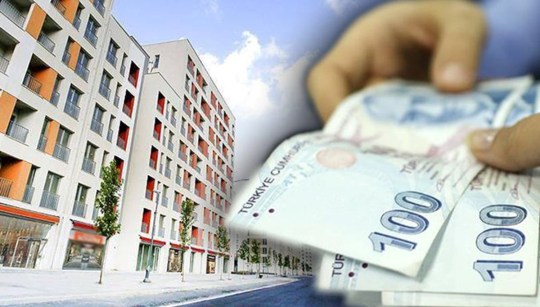
Sosyal konut projesinde başvurular yoğun ilgiyle devam ediyor. Proje kapsamında toplamda 500 bin sosyal konut, 250 bin konut arsası ve 50 bin iş yeri yapılacak. Bakanlık merak edilen 25 soruya yanıt verdi.
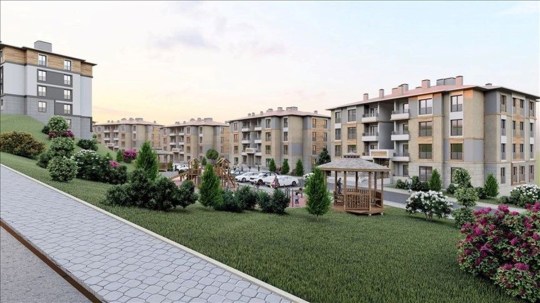
Cumhurbaşkanı Recep Tayyip Erdoğan’ın ayrıntılarını açıkladığı sosyal konut projesi kapsamında 500 bin sosyal konut, 250 bin konut arsası ve 50 bin iş yeri yapılacak. Projenin ilk etabında yapımına başlanacak 250 bin sosyal konut, 2 yıl içinde tamamlanacak.
Başvurular “şehit aileleri, terör, harp ve vazife malulleri”, “en az yüzde 40 engelli vatandaşlar”, “emekliler”, “18-30 yaş arasındaki gençler” ve “diğer alıcı adayları” olmak üzere 5 kategoride kabul edilecek.
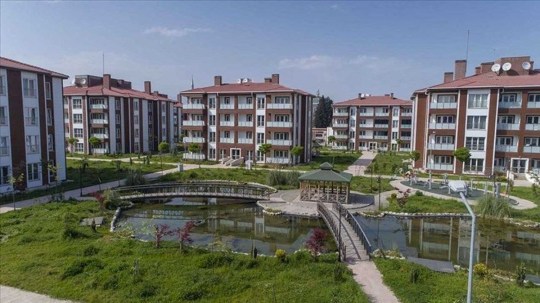
TOKİ aracılığıyla inşa edilecek konutlara, iş yerlerine ve konut arsalarına, proje ili sınırları içerisinde en az 1 yıl ikamet eden veya proje il nüfusuna kayıtlı, kendisi, eşi ve velayeti altındaki çocukları üzerine ülke sınırları içinde tapuda kayıtlı konutları bulunmayan, daha önce TOKİ aracılığıyla ev satın almamış 18 yaşını doldurmuş Türk vatandaşları başvurabilecek. Başvuru için hane halkı gelirinin İstanbul için net 18 bin, diğer şehirlerde ise 16 bin liranın altında olması gerekecek. Hane halkı geliri başvurucunun kendisi, eşi ve velayetleri altındaki 18 yaş altı çocuklarının toplam geliri dikkate alınarak hesaplanacak. Genel başvuru şartları haricinde başvuru koşullarına uygunluk için merak edilenler…

Başvurular, konut tipi (2+1 ve 3+1) ayrımı olmadan, proje bazında başvuru yapılacak.
(Hak sahiplerinin konut tipleri ihale yapıldıktan sonra gerçekleştirilecek olan “Konut Belirleme Kurası” ile belirlenecek.)

Bankaya dilekçeyle başvurarak hak sahipliğinin iptal edilmesini talep edip, yatırmış olduğu başvuru bedelini iade alan vatandaşlar 250 bin konut projesine başvuru yapabilir.

205 bin konut projesinde hane halkı adına, yalnızca bir adet başvuru yapılabilecek.
Her iki eşin de başvuru yapılması durumunda başvuruların tamamı geçersiz sayılacak.

Evet, başvurabiliyor.

Sadece bu kategoride yaş sınırı bulunmuyor.

Evet.

Banka şubelerinden başvuru yapacak olanlar, sadece projenin bulunduğu ildeki yetkili şubelerden başvuru yapılabilir.
Ancak e-devlet üzerinde şartların taşınması şartı ile istenilen yerden başvuru yapılabilir.

Gelir, konut olmama, ikametgah, yaş şartlarını başvuru tarihinde taşıması gerekiyor.
Daha sonraki değişiklikler dikkate alınmayacağı açıklandı.

Konut başvurusunda bulunan kişilerin kendisi, eşi ve velayeti altındaki çocukları üzerine tapuda kayıtlı bağımsız bir konutun bulunmaması, daha önce Toplu Konut İdaresince satılmış bir gayrimenkule sahip olmamış ve daha önce Toplu Konut İdaresinden kredi almamış olması şartı aranıyor.
Yapı kullanım belgesi başvuru şartları arasında yer almıyor.

Konutunu iade/fesih edenler ve işyeri alanlar da başvuru yapabilecek.
E-devletten başvuru yapılabilir mi?
Evet. Ancak E-devlet başvurularında başvuru yapabilmek için aktif bir başvurusunun olmaması gerekiyor.
Ancak sistemden veya kişini bilgilerinin eksikliğinden dolayı e-devlet başvuru yapılamadığında, bankadan başvurusu yapmalıdır.

Bağımsız ve tam hissesi olmadığı sürece başvuru yapılabilir.
Engelli ve kısıtlı kişilerin başvurusu nasıl olacaktır?
Başvuru şartlarında engelli kategorisinden başvuru yapılabilmesi için en az yüzde 40 engelli olunması gerekiyor.
18 yaşından küçük engelli çocuğu olan anne veya baba kendi adına Engelli kategorisinden başvuru yapabilecek.
18 yaşından büyük kısıtlı olan engelliler vasi/velileri aracılığı ile başvuru yapacaklar.
Bu konuda vasilik kararında hüküm bulunmalı (borçlandırma işlemlerine, konut alım işlemlerine yönelik) veya vasilik makamı olan mahkemeden uygunluk yazısı getirilmesi gerekiyor.

14 Eylül – 31 Ekim 2022 tarihlerinde başvuru yapılacak.
E-Devlet Başvuruları 28 Ekim 2022 tarihinde sona erecek.
Başvuru belgeleri; E-devletten başvuru yapanlar için, yapılan kura sonucunda hak sahibi kabul edilen kişilerden sözleşme aşamasında temin edilecektir. Banka aracılığı ile başvuru yapanlar kategorisine göre; engelli/emekli/genç/diğer durumu kanıtlayan belge ile ikamet/nüfus/gelir/yaş şartlarının belgelenmesi istenecek.

Aylık hane halkı gelirinin, en fazla net 16 bin TL (İstanbul İli için 18 bin TL) olması gerekiyor.
(Başvuru sahibinin ve eşinin gıda, yol, vs. her türlü aldıkları yardımlar dâhil olmak üzere toplam hane halkı aylık net gelirinin toplamı) Maaşında icra kesintisi olanların icra kesintisinden önceki geliri dikkate alınacak.

Ticari faaliyeti olanlarda son yıl vergi levhasında görünen yıllık net karın 12’ye bölünmesi sonucundaki değer ile gelir tespit edilecek. Zirai faaliyeti olanlarda ise (bilanço ve işletme esasına göre defter tutanlar hariç) beyan ettikleri gelirleri esas alınacak.
Geliri olmayanlar bu projelere başvurabilir mi?
TOKİ tarafından söz konusu projelere başvuru için asgari gelir düzeyi belirlenmedi.

İdarece inşa edilecek konut projelerinde; imar planlama, projelendirme ve ruhsatlandırma işlemlerinin tamamlanması ve ihale sürecini müteakip, konutların satış fiyatları belirleme işlemleri tamamlandıktan sonra sözleşme imzalama işlemleri başlatılacak.Konutu devir edebilir miyiz?
2+1 ve 3+1 konutlarda alıcının devir hakkı bulunmuyor.
Başvuru sürecinde, yapılan başvuru farklı proje ile değiştirilebilir mi?
250 bin konut projesinde herhangi bir projeye başvuru yaptıktan sonra, başka bir projeye başvuru yapılmak istenmesi durumunda, ilk başvuru yapılan projedeki başvurunun bankada iptal edilmesinden sonra ikinci bir projeye başvuru yapılabilir.

Peşinat oranını fazla ödeme imkanı bulunmakta olup, tamamen de kapatılabilir. Vadede kısaltma imkânı bulunmuyor.

İade etme hakkı bulunmakta olup, banka nezdinde imzalanan satış sözleşmesi hükümleri uyarınca işlem yapılacak.

İlgili projedeki sözleşme imzalama süresinin bitimini müteakiben başvuru iade işlemleri yapılacak
Konut değiştirme (becayiş) imkanı var mı?
Sözleşme imzalama aşamasında var.

Evet dahil ediliyor.
Daha Fazla Ekonomi Haberi için
Bakanlık tek tek yanıt verdi: 25 soruda Sosyal Konut Projesi yazısı ilk önce Deşifre Haberler üzerinde ortaya çıktı.
Read the full article
0 notes
Photo

Bishops and the Patriarch’s throne
Gold alone was not thought good enough for the altar; this was therefore made of a combination of gems set in silver and gold. The doors were of ivory, amber, and cedar, the outer one being silver- plated. The seven seats for the bishops and the Patriarch’s throne, forming a semicircle at the back of the altar, were all silver-plated. The building contains nearly every kind of known marble, comprising the green from Laconia, the white, black- veined Bosporus marble, the white Phrygian with its pink streaks, with others from Asia Minor and Egypt. The columns number 107 in all, of which 67 are in the galleries.
More or less extensive repairs have been effected by various emperors and sultans ; the last were in 1848, in the reign of Sultan Abd-ul-Medjid, and were entrusted to the Italian architects, Possati Brothers.
The Mosque of St. Sophia is 235 feet N. and S. by 250 feet E. and W. At its western end is an open court, the ancient Atrium (A), containing a round fountain, used for the Muhammadan ablutions. In the very centre of this court, very probably on the site of the Turkish fountain, stood the Phiale, a large marble basin with two jets of water constantly running, where worshippers performed their ablutions before entering the church, and which bore the inscription, NDBON ANOMH- MATA MH MONAN O’T’IN, signifying ‘ Cleanse thine iniquities, not thy face only curious from the fact of its reading the same whether perused the right way or backwards. The Outer Narthex (B) with its five doors was on the eastern side of the Atrium; and the belfry (C) was over the main entrance private istanbul tour. The Outer Narthex is devoid of any ornamentation; its five doors were called ‘ the Doors of the Armenians from the latter having taken part in the fifth General Council while the doors were being built. These gave access to the Inner Narthex.
MIXAHA NIKHTHN
Both the nartheces were reserved for catechumens and penitents. This latter hall is 205 feet long by 26 feet wide, and its walls and ceiling are covered with mosaic work. At its northern and at its southern sides are low doorways, giving access to the women’s galleries. The South porch, which is a double one, was reserved for the Emperor and his suite; it was erected by the Emperor Theo- philus, and is sheathed with bronze plating bearing several crosses and Byzantine monograms. At the top of the right-hand door is a fragment of an inscription, MIXAHA NIKHTHN (‘Michael of the Conquerors ’). All the doors bear crosses which the Turks have altered to resemble trident prongs.
The nave is entered through nine gates, the central one of which was formerly styled “ Pyle Vasilike ” or Royal Gate, and is that through which the Emperor entered, and where he was met by the Patriarch. On the bronze cornice over the gate is carved a lectern and a copy of the Gospels. The book is represented as open at the passage from St. John : ‘ I am the door : by me if any man enter in, he shall be saved, and shall go in and out, and find pasture ”. The four mosaic figures above this cornice are now but dimly visible through the wash the Turks have put over them. The figure between the medallions of the Virgin and St. John the Baptist is Christ seated on a throne. His right hand holds a volume open at the words ‘ Peace be unto you; I am the light of the world ’; and with his left he is blessing a kneeling emperor.
0 notes
Photo

Bishops and the Patriarch’s throne
Gold alone was not thought good enough for the altar; this was therefore made of a combination of gems set in silver and gold. The doors were of ivory, amber, and cedar, the outer one being silver- plated. The seven seats for the bishops and the Patriarch’s throne, forming a semicircle at the back of the altar, were all silver-plated. The building contains nearly every kind of known marble, comprising the green from Laconia, the white, black- veined Bosporus marble, the white Phrygian with its pink streaks, with others from Asia Minor and Egypt. The columns number 107 in all, of which 67 are in the galleries.
More or less extensive repairs have been effected by various emperors and sultans ; the last were in 1848, in the reign of Sultan Abd-ul-Medjid, and were entrusted to the Italian architects, Possati Brothers.
The Mosque of St. Sophia is 235 feet N. and S. by 250 feet E. and W. At its western end is an open court, the ancient Atrium (A), containing a round fountain, used for the Muhammadan ablutions. In the very centre of this court, very probably on the site of the Turkish fountain, stood the Phiale, a large marble basin with two jets of water constantly running, where worshippers performed their ablutions before entering the church, and which bore the inscription, NDBON ANOMH- MATA MH MONAN O’T’IN, signifying ‘ Cleanse thine iniquities, not thy face only curious from the fact of its reading the same whether perused the right way or backwards. The Outer Narthex (B) with its five doors was on the eastern side of the Atrium; and the belfry (C) was over the main entrance private istanbul tour. The Outer Narthex is devoid of any ornamentation; its five doors were called ‘ the Doors of the Armenians from the latter having taken part in the fifth General Council while the doors were being built. These gave access to the Inner Narthex.
MIXAHA NIKHTHN
Both the nartheces were reserved for catechumens and penitents. This latter hall is 205 feet long by 26 feet wide, and its walls and ceiling are covered with mosaic work. At its northern and at its southern sides are low doorways, giving access to the women’s galleries. The South porch, which is a double one, was reserved for the Emperor and his suite; it was erected by the Emperor Theo- philus, and is sheathed with bronze plating bearing several crosses and Byzantine monograms. At the top of the right-hand door is a fragment of an inscription, MIXAHA NIKHTHN (‘Michael of the Conquerors ’). All the doors bear crosses which the Turks have altered to resemble trident prongs.
The nave is entered through nine gates, the central one of which was formerly styled “ Pyle Vasilike ” or Royal Gate, and is that through which the Emperor entered, and where he was met by the Patriarch. On the bronze cornice over the gate is carved a lectern and a copy of the Gospels. The book is represented as open at the passage from St. John : ‘ I am the door : by me if any man enter in, he shall be saved, and shall go in and out, and find pasture ”. The four mosaic figures above this cornice are now but dimly visible through the wash the Turks have put over them. The figure between the medallions of the Virgin and St. John the Baptist is Christ seated on a throne. His right hand holds a volume open at the words ‘ Peace be unto you; I am the light of the world ’; and with his left he is blessing a kneeling emperor.
0 notes
Photo
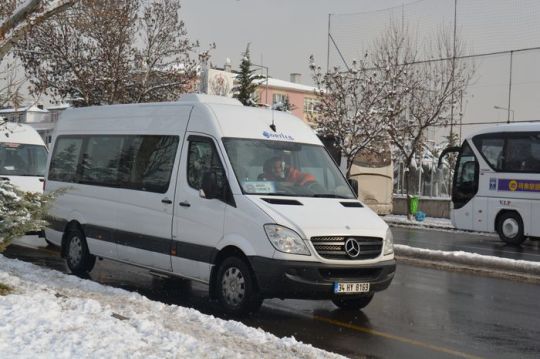
Bishops and the Patriarch’s throne
Gold alone was not thought good enough for the altar; this was therefore made of a combination of gems set in silver and gold. The doors were of ivory, amber, and cedar, the outer one being silver- plated. The seven seats for the bishops and the Patriarch’s throne, forming a semicircle at the back of the altar, were all silver-plated. The building contains nearly every kind of known marble, comprising the green from Laconia, the white, black- veined Bosporus marble, the white Phrygian with its pink streaks, with others from Asia Minor and Egypt. The columns number 107 in all, of which 67 are in the galleries.
More or less extensive repairs have been effected by various emperors and sultans ; the last were in 1848, in the reign of Sultan Abd-ul-Medjid, and were entrusted to the Italian architects, Possati Brothers.
The Mosque of St. Sophia is 235 feet N. and S. by 250 feet E. and W. At its western end is an open court, the ancient Atrium (A), containing a round fountain, used for the Muhammadan ablutions. In the very centre of this court, very probably on the site of the Turkish fountain, stood the Phiale, a large marble basin with two jets of water constantly running, where worshippers performed their ablutions before entering the church, and which bore the inscription, NDBON ANOMH- MATA MH MONAN O’T’IN, signifying ‘ Cleanse thine iniquities, not thy face only curious from the fact of its reading the same whether perused the right way or backwards. The Outer Narthex (B) with its five doors was on the eastern side of the Atrium; and the belfry (C) was over the main entrance private istanbul tour. The Outer Narthex is devoid of any ornamentation; its five doors were called ‘ the Doors of the Armenians from the latter having taken part in the fifth General Council while the doors were being built. These gave access to the Inner Narthex.
MIXAHA NIKHTHN
Both the nartheces were reserved for catechumens and penitents. This latter hall is 205 feet long by 26 feet wide, and its walls and ceiling are covered with mosaic work. At its northern and at its southern sides are low doorways, giving access to the women’s galleries. The South porch, which is a double one, was reserved for the Emperor and his suite; it was erected by the Emperor Theo- philus, and is sheathed with bronze plating bearing several crosses and Byzantine monograms. At the top of the right-hand door is a fragment of an inscription, MIXAHA NIKHTHN (‘Michael of the Conquerors ’). All the doors bear crosses which the Turks have altered to resemble trident prongs.
The nave is entered through nine gates, the central one of which was formerly styled “ Pyle Vasilike ” or Royal Gate, and is that through which the Emperor entered, and where he was met by the Patriarch. On the bronze cornice over the gate is carved a lectern and a copy of the Gospels. The book is represented as open at the passage from St. John : ‘ I am the door : by me if any man enter in, he shall be saved, and shall go in and out, and find pasture ”. The four mosaic figures above this cornice are now but dimly visible through the wash the Turks have put over them. The figure between the medallions of the Virgin and St. John the Baptist is Christ seated on a throne. His right hand holds a volume open at the words ‘ Peace be unto you; I am the light of the world ’; and with his left he is blessing a kneeling emperor.
0 notes
Photo

Bishops and the Patriarch’s throne
Gold alone was not thought good enough for the altar; this was therefore made of a combination of gems set in silver and gold. The doors were of ivory, amber, and cedar, the outer one being silver- plated. The seven seats for the bishops and the Patriarch’s throne, forming a semicircle at the back of the altar, were all silver-plated. The building contains nearly every kind of known marble, comprising the green from Laconia, the white, black- veined Bosporus marble, the white Phrygian with its pink streaks, with others from Asia Minor and Egypt. The columns number 107 in all, of which 67 are in the galleries.
More or less extensive repairs have been effected by various emperors and sultans ; the last were in 1848, in the reign of Sultan Abd-ul-Medjid, and were entrusted to the Italian architects, Possati Brothers.
The Mosque of St. Sophia is 235 feet N. and S. by 250 feet E. and W. At its western end is an open court, the ancient Atrium (A), containing a round fountain, used for the Muhammadan ablutions. In the very centre of this court, very probably on the site of the Turkish fountain, stood the Phiale, a large marble basin with two jets of water constantly running, where worshippers performed their ablutions before entering the church, and which bore the inscription, NDBON ANOMH- MATA MH MONAN O’T’IN, signifying ‘ Cleanse thine iniquities, not thy face only curious from the fact of its reading the same whether perused the right way or backwards. The Outer Narthex (B) with its five doors was on the eastern side of the Atrium; and the belfry (C) was over the main entrance private istanbul tour. The Outer Narthex is devoid of any ornamentation; its five doors were called ‘ the Doors of the Armenians from the latter having taken part in the fifth General Council while the doors were being built. These gave access to the Inner Narthex.
MIXAHA NIKHTHN
Both the nartheces were reserved for catechumens and penitents. This latter hall is 205 feet long by 26 feet wide, and its walls and ceiling are covered with mosaic work. At its northern and at its southern sides are low doorways, giving access to the women’s galleries. The South porch, which is a double one, was reserved for the Emperor and his suite; it was erected by the Emperor Theo- philus, and is sheathed with bronze plating bearing several crosses and Byzantine monograms. At the top of the right-hand door is a fragment of an inscription, MIXAHA NIKHTHN (‘Michael of the Conquerors ’). All the doors bear crosses which the Turks have altered to resemble trident prongs.
The nave is entered through nine gates, the central one of which was formerly styled “ Pyle Vasilike ” or Royal Gate, and is that through which the Emperor entered, and where he was met by the Patriarch. On the bronze cornice over the gate is carved a lectern and a copy of the Gospels. The book is represented as open at the passage from St. John : ‘ I am the door : by me if any man enter in, he shall be saved, and shall go in and out, and find pasture ”. The four mosaic figures above this cornice are now but dimly visible through the wash the Turks have put over them. The figure between the medallions of the Virgin and St. John the Baptist is Christ seated on a throne. His right hand holds a volume open at the words ‘ Peace be unto you; I am the light of the world ’; and with his left he is blessing a kneeling emperor.
0 notes
Photo
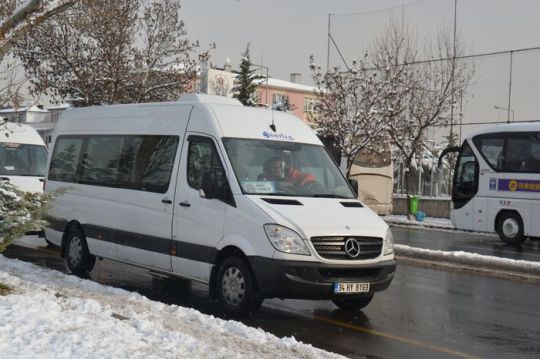
Bishops and the Patriarch’s throne
Gold alone was not thought good enough for the altar; this was therefore made of a combination of gems set in silver and gold. The doors were of ivory, amber, and cedar, the outer one being silver- plated. The seven seats for the bishops and the Patriarch’s throne, forming a semicircle at the back of the altar, were all silver-plated. The building contains nearly every kind of known marble, comprising the green from Laconia, the white, black- veined Bosporus marble, the white Phrygian with its pink streaks, with others from Asia Minor and Egypt. The columns number 107 in all, of which 67 are in the galleries.
More or less extensive repairs have been effected by various emperors and sultans ; the last were in 1848, in the reign of Sultan Abd-ul-Medjid, and were entrusted to the Italian architects, Possati Brothers.
The Mosque of St. Sophia is 235 feet N. and S. by 250 feet E. and W. At its western end is an open court, the ancient Atrium (A), containing a round fountain, used for the Muhammadan ablutions. In the very centre of this court, very probably on the site of the Turkish fountain, stood the Phiale, a large marble basin with two jets of water constantly running, where worshippers performed their ablutions before entering the church, and which bore the inscription, NDBON ANOMH- MATA MH MONAN O’T’IN, signifying ‘ Cleanse thine iniquities, not thy face only curious from the fact of its reading the same whether perused the right way or backwards. The Outer Narthex (B) with its five doors was on the eastern side of the Atrium; and the belfry (C) was over the main entrance private istanbul tour. The Outer Narthex is devoid of any ornamentation; its five doors were called ‘ the Doors of the Armenians from the latter having taken part in the fifth General Council while the doors were being built. These gave access to the Inner Narthex.
MIXAHA NIKHTHN
Both the nartheces were reserved for catechumens and penitents. This latter hall is 205 feet long by 26 feet wide, and its walls and ceiling are covered with mosaic work. At its northern and at its southern sides are low doorways, giving access to the women’s galleries. The South porch, which is a double one, was reserved for the Emperor and his suite; it was erected by the Emperor Theo- philus, and is sheathed with bronze plating bearing several crosses and Byzantine monograms. At the top of the right-hand door is a fragment of an inscription, MIXAHA NIKHTHN (‘Michael of the Conquerors ’). All the doors bear crosses which the Turks have altered to resemble trident prongs.
The nave is entered through nine gates, the central one of which was formerly styled “ Pyle Vasilike ” or Royal Gate, and is that through which the Emperor entered, and where he was met by the Patriarch. On the bronze cornice over the gate is carved a lectern and a copy of the Gospels. The book is represented as open at the passage from St. John : ‘ I am the door : by me if any man enter in, he shall be saved, and shall go in and out, and find pasture ”. The four mosaic figures above this cornice are now but dimly visible through the wash the Turks have put over them. The figure between the medallions of the Virgin and St. John the Baptist is Christ seated on a throne. His right hand holds a volume open at the words ‘ Peace be unto you; I am the light of the world ’; and with his left he is blessing a kneeling emperor.
0 notes
Text
Me watching a murder mystery vid:
Vasilikou: and so that's how Jeffrey Dahmer cleans bones-
Random add: iS yOuR sKiN cLeAn? *random model poses*
#that fact that the YouTuber stoped talking cause she heard someone in the house (her roommate came home) and then a random add pops up💀#stfu#vasilikou#Jeffrey Dahmer
3 notes
·
View notes
Photo
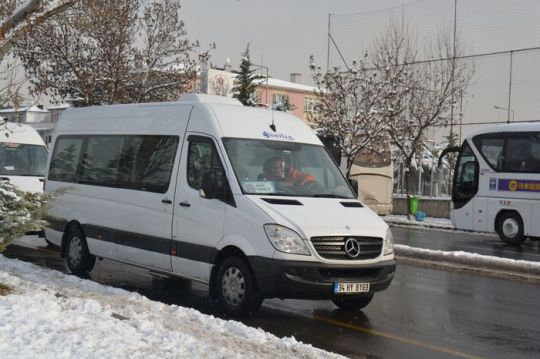
Bishops and the Patriarch’s throne
Gold alone was not thought good enough for the altar; this was therefore made of a combination of gems set in silver and gold. The doors were of ivory, amber, and cedar, the outer one being silver- plated. The seven seats for the bishops and the Patriarch’s throne, forming a semicircle at the back of the altar, were all silver-plated. The building contains nearly every kind of known marble, comprising the green from Laconia, the white, black- veined Bosporus marble, the white Phrygian with its pink streaks, with others from Asia Minor and Egypt. The columns number 107 in all, of which 67 are in the galleries.
More or less extensive repairs have been effected by various emperors and sultans ; the last were in 1848, in the reign of Sultan Abd-ul-Medjid, and were entrusted to the Italian architects, Possati Brothers.
The Mosque of St. Sophia is 235 feet N. and S. by 250 feet E. and W. At its western end is an open court, the ancient Atrium (A), containing a round fountain, used for the Muhammadan ablutions. In the very centre of this court, very probably on the site of the Turkish fountain, stood the Phiale, a large marble basin with two jets of water constantly running, where worshippers performed their ablutions before entering the church, and which bore the inscription, NDBON ANOMH- MATA MH MONAN O’T’IN, signifying ‘ Cleanse thine iniquities, not thy face only curious from the fact of its reading the same whether perused the right way or backwards. The Outer Narthex (B) with its five doors was on the eastern side of the Atrium; and the belfry (C) was over the main entrance private istanbul tour. The Outer Narthex is devoid of any ornamentation; its five doors were called ‘ the Doors of the Armenians from the latter having taken part in the fifth General Council while the doors were being built. These gave access to the Inner Narthex.
MIXAHA NIKHTHN
Both the nartheces were reserved for catechumens and penitents. This latter hall is 205 feet long by 26 feet wide, and its walls and ceiling are covered with mosaic work. At its northern and at its southern sides are low doorways, giving access to the women’s galleries. The South porch, which is a double one, was reserved for the Emperor and his suite; it was erected by the Emperor Theo- philus, and is sheathed with bronze plating bearing several crosses and Byzantine monograms. At the top of the right-hand door is a fragment of an inscription, MIXAHA NIKHTHN (‘Michael of the Conquerors ’). All the doors bear crosses which the Turks have altered to resemble trident prongs.
The nave is entered through nine gates, the central one of which was formerly styled “ Pyle Vasilike ” or Royal Gate, and is that through which the Emperor entered, and where he was met by the Patriarch. On the bronze cornice over the gate is carved a lectern and a copy of the Gospels. The book is represented as open at the passage from St. John : ‘ I am the door : by me if any man enter in, he shall be saved, and shall go in and out, and find pasture ”. The four mosaic figures above this cornice are now but dimly visible through the wash the Turks have put over them. The figure between the medallions of the Virgin and St. John the Baptist is Christ seated on a throne. His right hand holds a volume open at the words ‘ Peace be unto you; I am the light of the world ’; and with his left he is blessing a kneeling emperor.
0 notes
Photo

Bishops and the Patriarch’s throne
Gold alone was not thought good enough for the altar; this was therefore made of a combination of gems set in silver and gold. The doors were of ivory, amber, and cedar, the outer one being silver- plated. The seven seats for the bishops and the Patriarch’s throne, forming a semicircle at the back of the altar, were all silver-plated. The building contains nearly every kind of known marble, comprising the green from Laconia, the white, black- veined Bosporus marble, the white Phrygian with its pink streaks, with others from Asia Minor and Egypt. The columns number 107 in all, of which 67 are in the galleries.
More or less extensive repairs have been effected by various emperors and sultans ; the last were in 1848, in the reign of Sultan Abd-ul-Medjid, and were entrusted to the Italian architects, Possati Brothers.
The Mosque of St. Sophia is 235 feet N. and S. by 250 feet E. and W. At its western end is an open court, the ancient Atrium (A), containing a round fountain, used for the Muhammadan ablutions. In the very centre of this court, very probably on the site of the Turkish fountain, stood the Phiale, a large marble basin with two jets of water constantly running, where worshippers performed their ablutions before entering the church, and which bore the inscription, NDBON ANOMH- MATA MH MONAN O’T’IN, signifying ‘ Cleanse thine iniquities, not thy face only curious from the fact of its reading the same whether perused the right way or backwards. The Outer Narthex (B) with its five doors was on the eastern side of the Atrium; and the belfry (C) was over the main entrance private istanbul tour. The Outer Narthex is devoid of any ornamentation; its five doors were called ‘ the Doors of the Armenians from the latter having taken part in the fifth General Council while the doors were being built. These gave access to the Inner Narthex.
MIXAHA NIKHTHN
Both the nartheces were reserved for catechumens and penitents. This latter hall is 205 feet long by 26 feet wide, and its walls and ceiling are covered with mosaic work. At its northern and at its southern sides are low doorways, giving access to the women’s galleries. The South porch, which is a double one, was reserved for the Emperor and his suite; it was erected by the Emperor Theo- philus, and is sheathed with bronze plating bearing several crosses and Byzantine monograms. At the top of the right-hand door is a fragment of an inscription, MIXAHA NIKHTHN (‘Michael of the Conquerors ’). All the doors bear crosses which the Turks have altered to resemble trident prongs.
The nave is entered through nine gates, the central one of which was formerly styled “ Pyle Vasilike ” or Royal Gate, and is that through which the Emperor entered, and where he was met by the Patriarch. On the bronze cornice over the gate is carved a lectern and a copy of the Gospels. The book is represented as open at the passage from St. John : ‘ I am the door : by me if any man enter in, he shall be saved, and shall go in and out, and find pasture ”. The four mosaic figures above this cornice are now but dimly visible through the wash the Turks have put over them. The figure between the medallions of the Virgin and St. John the Baptist is Christ seated on a throne. His right hand holds a volume open at the words ‘ Peace be unto you; I am the light of the world ’; and with his left he is blessing a kneeling emperor.
0 notes
Photo

Bishops and the Patriarch’s throne
Gold alone was not thought good enough for the altar; this was therefore made of a combination of gems set in silver and gold. The doors were of ivory, amber, and cedar, the outer one being silver- plated. The seven seats for the bishops and the Patriarch’s throne, forming a semicircle at the back of the altar, were all silver-plated. The building contains nearly every kind of known marble, comprising the green from Laconia, the white, black- veined Bosporus marble, the white Phrygian with its pink streaks, with others from Asia Minor and Egypt. The columns number 107 in all, of which 67 are in the galleries.
More or less extensive repairs have been effected by various emperors and sultans ; the last were in 1848, in the reign of Sultan Abd-ul-Medjid, and were entrusted to the Italian architects, Possati Brothers.
The Mosque of St. Sophia is 235 feet N. and S. by 250 feet E. and W. At its western end is an open court, the ancient Atrium (A), containing a round fountain, used for the Muhammadan ablutions. In the very centre of this court, very probably on the site of the Turkish fountain, stood the Phiale, a large marble basin with two jets of water constantly running, where worshippers performed their ablutions before entering the church, and which bore the inscription, NDBON ANOMH- MATA MH MONAN O’T’IN, signifying ‘ Cleanse thine iniquities, not thy face only curious from the fact of its reading the same whether perused the right way or backwards. The Outer Narthex (B) with its five doors was on the eastern side of the Atrium; and the belfry (C) was over the main entrance private istanbul tour. The Outer Narthex is devoid of any ornamentation; its five doors were called ‘ the Doors of the Armenians from the latter having taken part in the fifth General Council while the doors were being built. These gave access to the Inner Narthex.
MIXAHA NIKHTHN
Both the nartheces were reserved for catechumens and penitents. This latter hall is 205 feet long by 26 feet wide, and its walls and ceiling are covered with mosaic work. At its northern and at its southern sides are low doorways, giving access to the women’s galleries. The South porch, which is a double one, was reserved for the Emperor and his suite; it was erected by the Emperor Theo- philus, and is sheathed with bronze plating bearing several crosses and Byzantine monograms. At the top of the right-hand door is a fragment of an inscription, MIXAHA NIKHTHN (‘Michael of the Conquerors ’). All the doors bear crosses which the Turks have altered to resemble trident prongs.
The nave is entered through nine gates, the central one of which was formerly styled “ Pyle Vasilike ” or Royal Gate, and is that through which the Emperor entered, and where he was met by the Patriarch. On the bronze cornice over the gate is carved a lectern and a copy of the Gospels. The book is represented as open at the passage from St. John : ‘ I am the door : by me if any man enter in, he shall be saved, and shall go in and out, and find pasture ”. The four mosaic figures above this cornice are now but dimly visible through the wash the Turks have put over them. The figure between the medallions of the Virgin and St. John the Baptist is Christ seated on a throne. His right hand holds a volume open at the words ‘ Peace be unto you; I am the light of the world ’; and with his left he is blessing a kneeling emperor.
0 notes